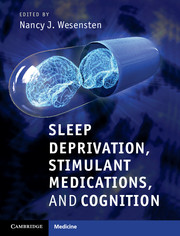Book contents
- Sleep Deprivation, Stimulant Medications, and Cognition
- Sleep Deprivation, Stimulant Medications, and Cognition
- Copyright page
- Contents
- Contributors
- Foreword: Sustaining cognitive performance: a modern imperative
- Preface
- Section 1 Basic Mechanisms: Cognitive Performance and Sleep
- Section 2 Stimulant Reversal of Cognitive Deficits
- Chapter 5 Modafinil reversal of cognitive deficits during sleep loss
- Chapter 6 Utility of caffeine: evidence from the laboratory
- Chapter 7 Caffeine: mechanism of action, genetics, and behavioral studies conducted in task simulators and the field
- Chapter 8 Stimulants in models of shift work and shift work disorder
- Chapter 9 The potential for abuse of stimulants in chronically sleep-restricted populations
- Chapter 10 Cognitive enhancers versus stimulants
- Chapter 11 Novel pathways for stimulant development I: targeting the histaminergic system
- Chapter 12 Novel pathways for stimulant development II: the hypocretin/orexin system
- Section 3 Alternatives for Sustaining Cognitive Performance During Sleep Loss
- Section 4 Summary and Conclusions
- Index
Chapter 7 - Caffeine: mechanism of action, genetics, and behavioral studies conducted in task simulators and the field
from Section 2 - Stimulant Reversal of Cognitive Deficits
Published online by Cambridge University Press: 05 September 2012
- Sleep Deprivation, Stimulant Medications, and Cognition
- Sleep Deprivation, Stimulant Medications, and Cognition
- Copyright page
- Contents
- Contributors
- Foreword: Sustaining cognitive performance: a modern imperative
- Preface
- Section 1 Basic Mechanisms: Cognitive Performance and Sleep
- Section 2 Stimulant Reversal of Cognitive Deficits
- Chapter 5 Modafinil reversal of cognitive deficits during sleep loss
- Chapter 6 Utility of caffeine: evidence from the laboratory
- Chapter 7 Caffeine: mechanism of action, genetics, and behavioral studies conducted in task simulators and the field
- Chapter 8 Stimulants in models of shift work and shift work disorder
- Chapter 9 The potential for abuse of stimulants in chronically sleep-restricted populations
- Chapter 10 Cognitive enhancers versus stimulants
- Chapter 11 Novel pathways for stimulant development I: targeting the histaminergic system
- Chapter 12 Novel pathways for stimulant development II: the hypocretin/orexin system
- Section 3 Alternatives for Sustaining Cognitive Performance During Sleep Loss
- Section 4 Summary and Conclusions
- Index
Summary
- Type
- Chapter
- Information
- Sleep Deprivation, Stimulant Medications, and Cognition , pp. 93 - 107Publisher: Cambridge University PressPrint publication year: 2012
- 9
- Cited by

